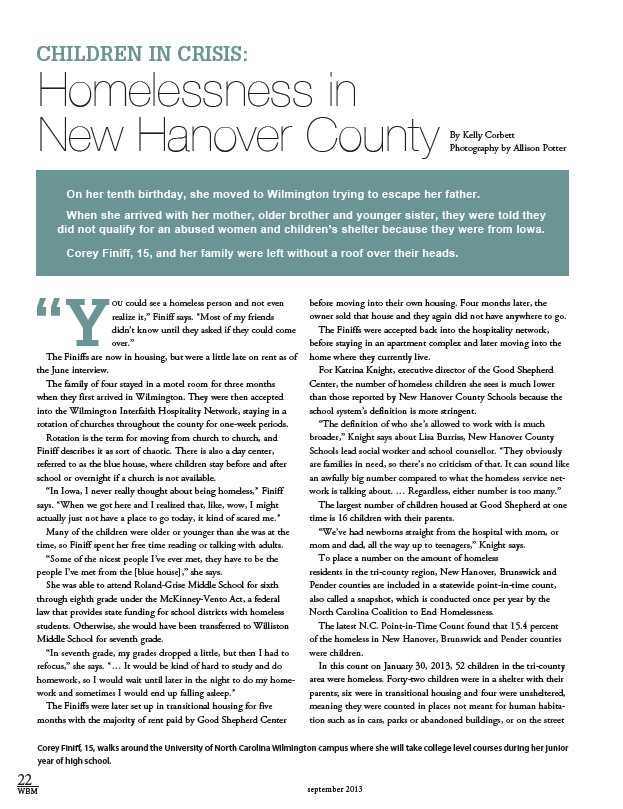
On her tenth birthday, she moved to Wilmington trying to escape her father.
When she arrived with her mother, older brother and younger sister, they were told they
did not qualify for an abused women and children’s shelter because they were from Iowa.
Corey Finiff, 15, and her family were left without a roof over their heads.
“You could see a homeless person and not even
realize it,” Finiff says. “Most of my friends
didn’t know until they asked if they could come
over.”
The Finiffs are now in housing, but were a little late on rent as of
the June interview.
The family of four stayed in a motel room for three months
when they first arrived in Wilmington. They were then accepted
into the Wilmington Interfaith Hospitality Network, staying in a
rotation of churches throughout the county for one-week periods.
Rotation is the term for moving from church to church, and
Finiff describes it as sort of chaotic. There is also a day center,
referred to as the blue house, where children stay before and after
school or overnight if a church is not available.
“In Iowa, I never really thought about being homeless,” Finiff
says. “When we got here and I realized that, like, wow, I might
actually just not have a place to go today, it kind of scared me.”
Many of the children were older or younger than she was at the
time, so Finiff spent her free time reading or talking with adults.
“Some of the nicest people I’ve ever met, they have to be the
people I’ve met from the blue house,” she says.
She was able to attend Roland-Grise Middle School for sixth
through eighth grade under the McKinney-Vento Act, a federal
law that provides state funding for school districts with homeless
students. Otherwise, she would have been transferred to Williston
Middle School for seventh grade.
“In seventh grade, my grades dropped a little, but then I had to
refocus,” she says. “… It would be kind of hard to study and do
homework, so I would wait until later in the night to do my homework
and sometimes I would end up falling asleep.”
The Finiffs were later set up in transitional housing for five
months with the majority of rent paid by Good Shepherd Center
before moving into their own housing. Four months later, the
owner sold that house and they again did not have anywhere to go.
The Finiffs were accepted back into the hospitality network,
before staying in an apartment complex and later moving into the
home where they currently live.
For Katrina Knight, executive director of the Good Shepherd
Center, the number of homeless children she sees is much lower
than those reported by New Hanover County Schools because the
school system’s definition is more stringent.
“The definition of who she’s allowed to work with is much
broader,” Knight says about Lisa Burriss, New Hanover County
Schools lead social worker and school counsellor. “They obviously
are families in need, so there’s no criticism of that. It can sound like
an awfully big number compared to what the homeless service network
is talking about. … Regardless, either number is too many.”
The largest number of children housed at Good Shepherd at one
time is 16 children with their parents.
“We’ve had newborns straight from the hospital with mom, or
mom and dad, all the way up to teenagers,” Knight says.
To place a number on the amount of homeless
residents in the tri-county region, New Hanover, Brunswick and
Pender counties are included in a statewide point-in-time count,
also called a snapshot, which is conducted once per year by the
North Carolina Coalition to End Homelessness.
The latest N.C. Point-in-Time Count found that 15.4 percent
of the homeless in New Hanover, Brunswick and Pender counties
were children.
In this count on January 30, 2013, 52 children in the tri-county
area were homeless. Forty-two children were in a shelter with their
parents; six were in transitional housing and four were unsheltered,
meaning they were counted in places not meant for human habitation
such as in cars, parks or abandoned buildings, or on the street
Corey Finiff, 15, walks around the University of North Carolina Wilmington campus where she will take college level courses during her junior
year of high school.
22
WBM september 2013
By Kelly Corbett
Photography by Allison Potter
Homelessness in
New Hanover County
children in crisis: